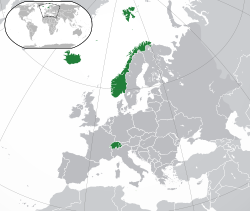European Free Trade Association
|
European Free Trade Association |
|
|---|---|

Logo
|
|

Location of the EFTA (green)
in Europe (green & dark grey) |
|
| Secretariat |
Geneva 46°57′N 7°27′E / 46.950°N 7.450°E |
| Largest city |
Oslo 59°56′N 10°41′E / 59.933°N 10.683°E |
| Official working language |
English |
| Official languages of member states |
|
| Type | Regional organisation, free trade area |
| Member states | |
| Leaders | |
|
• Secretary General
|
Kristinn F. Árnason |
|
• Council Chair
|
Iceland |
| Establishment | |
|
• Convention signed
|
4 January 1960 |
|
• Established
|
3 May 1960 |
| Area | |
|
• Total
|
529,600 km2 (204,500 sq mi) |
| Population | |
|
• 2012 estimate
|
13,589,956 |
|
• Density
|
100.6/km2 (260.6/sq mi) |
| GDP (PPP) | 2011 IMF estimate |
|
• Total
|
$623.5 billion |
|
• Per capita
|
$44,828 |
| GDP (nominal) | 2011 IMF estimate |
|
• Total
|
$1138.8 billion |
|
• Per capita
|
$58,714 |
| Currency | |
| Time zone |
WET (UTC) CET (UTC+1) |
|
• Summer (DST)
|
CEST (UTC+2) |
| Note: Iceland observes WET all year, while Liechtenstein, Norway, and Switzerland observe CET and CEST. | |
|
Website
efta |
|
in Europe (green & dark grey)
The European Free Trade Association (EFTA) is a regional trade organisation and free trade area consisting of four European states: Iceland, Liechtenstein, Norway, and Switzerland. The organisation operates in parallel with the European Union (EU), and all four member states participate in the EU's single market.
The EFTA was established on 3 May 1960 as an alternative trade bloc for European states who were unable or unwilling to join the then European Economic Community (EEC) (which subsequently became the EU). The Stockholm Convention, establishing EFTA, was signed on 4 January 1960 in the Swedish capital by seven countries (known as the "outer seven"). Today only two founding members remain: Norway and Switzerland. The other five were Austria, Denmark, Portugal, Sweden and the United Kingdom. The initial Stockholm Convention was superseded by the Vaduz Convention, with the aim of providing a successful framework for continued expansion and liberalization of trade among the organisation's member states and with the rest of the world.
While the EFTA is not a customs union and member states have full rights to enter into bilateral third-country trade arrangements, it does have a co-ordinated trade policy. As a result, its member states have jointly concluded free trade agreements with a number of other countries. To participate in the EU's single market, Iceland, Liechtenstein and Norway are party to the Agreement on a European Economic Area (EEA), with compliance regulated by the EFTA Surveillance Authority and the EFTA Court. Switzerland instead has a set of bilateral agreements with the EU.
...
Wikipedia
